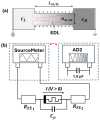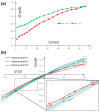Composite Behavior of Nanopore Array Large Memristors
- PMID: 40872389
- PMCID: PMC12388671
- DOI: 10.3390/mi16080882
Composite Behavior of Nanopore Array Large Memristors
Abstract
Synthetic nanopores were recently demonstrated with memristive and nonlinear voltage-current behaviors, akin to ion channels in a cell membrane. Such ionic devices are considered a promising candidate for the development of brain-inspired neuromorphic computing techniques. In this work, we show the composite behavior of nanopore-array large memristors, formed with different membrane materials, pore sizes, electrolytes, and device arrangements. Anodic aluminum oxide (AAO) membranes with 5 nm and 20 nm diameter pores and track-etched polycarbonate (PCTE) membranes with 10 nm diameter pores are tested and shown to demonstrate memristive and nonlinear behaviors with approximately 107-1010 pores in parallel when electrolyte concentration across the membranes is asymmetric. Ion diffusion through the large number of channels induces time-dependent electrolyte asymmetry that drives the system through different memristive states. The behaviors of series composite memristors with different configurations are also presented. In addition to helping understand fluidic devices and circuits for neuromorphic computing, the results also shed light on the development of field-assisted ion-selection-membrane filtration techniques as well as the investigations of large neurons and giant synapses. Further work is needed to de-embed parasitic components of the measurement setup to obtain intrinsic large memristor properties.
Keywords: membranes; memristors; nanofluidics; nanopores; rectification.
Conflict of interest statement
The authors declare no conflicts of interest.
Figures









Similar articles
-
Prescription of Controlled Substances: Benefits and Risks.2025 Jul 6. In: StatPearls [Internet]. Treasure Island (FL): StatPearls Publishing; 2025 Jan–. 2025 Jul 6. In: StatPearls [Internet]. Treasure Island (FL): StatPearls Publishing; 2025 Jan–. PMID: 30726003 Free Books & Documents.
-
Aerolysin Nanopore Electrochemistry.Acc Chem Res. 2025 Feb 18;58(4):517-528. doi: 10.1021/acs.accounts.4c00630. Epub 2025 Jan 28. Acc Chem Res. 2025. PMID: 39874057 Review.
-
Emerging Liquid-Based Memristive Devices for Neuromorphic Computation.Small Methods. 2025 Aug;9(8):e2402218. doi: 10.1002/smtd.202402218. Epub 2025 Mar 18. Small Methods. 2025. PMID: 40099617 Review.
-
Electrophoresis.2025 Jul 14. In: StatPearls [Internet]. Treasure Island (FL): StatPearls Publishing; 2025 Jan–. 2025 Jul 14. In: StatPearls [Internet]. Treasure Island (FL): StatPearls Publishing; 2025 Jan–. PMID: 36251838 Free Books & Documents.
-
Comparison of cellulose, modified cellulose and synthetic membranes in the haemodialysis of patients with end-stage renal disease.Cochrane Database Syst Rev. 2001;(3):CD003234. doi: 10.1002/14651858.CD003234. Cochrane Database Syst Rev. 2001. Update in: Cochrane Database Syst Rev. 2005 Jul 20;(3):CD003234. doi: 10.1002/14651858.CD003234.pub2. PMID: 11687058 Updated.
References
-
- Islam R., Li H., Chen P.-Y., Wan W., Chen H.-Y., Gao B., Wu H., Yu S., Saraswat K., Wong H.P. Device and materials requirements for neuromorphic computing. J. Phys. D Appl. Phys. 2019;52:113001. doi: 10.1088/1361-6463/aaf784. - DOI
-
- Chua L. Memristor-the missing circuit element. IEEE Trans. Circuit Theory. 1971;18:507–519. doi: 10.1109/TCT.1971.1083337. - DOI
Grants and funding
LinkOut - more resources
Full Text Sources

